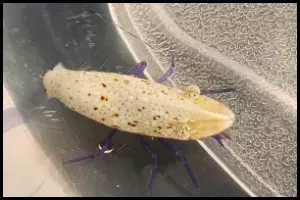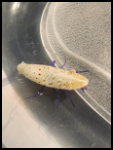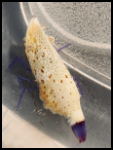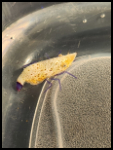




Quick Care Details (Table)
| Livestock Characteristics | Value |
|---|---|
| Care Level | Easy |
| Temperament | Semi-Agressive |
| Diet | Omnivore |
| Maximum Size | 2 Inches |
| Minimum Tank Size | 20 Gallons |
| Reef Safe | No |
| Temperature Range | 75-82°F |
| PH Range | 8.1-8.4 pH |
Species Specific Categories
Helpful Video
Care Details
Aquascape: Try to replicate the ocean floor around 200 feet below. The standard marine aquarium should fit this bill well, offering lots of grazing space and cover for them to hide.
Substrate: These shrimp do not care much about their substrate. Any grain of sand will work, and even a bare bottom is fine.
Disease prevention: These are susceptible to bacterial infections. Common parasites to keep an eye out for would also be nematodes, roundworms, and tapeworms.
Filtration: Standard marine filtration will be a good fit. Include lots of live rock and flow.
Lighting: These shrimp do not have specific lighting needs.
Water Flow: low to medium flow would best suit these shrimp
Hardiness: These shrimp need very stable tanks and are not able to handle large fluctuations in water parameters.
Acclimation: They need very long acclimation periods. You will want to aim for 4-8 hours of a slow drip.
Temperament and Behavior
Behavior and Social Interaction: They exhibit normal shrimp behaviors, but do not like to be kept with other peanut shrimp.
Aggression: Saron Rectirostris are fairly peaceful with other fish and invertebrates, but exhibit high levels of aggression against other Peanut shrimp.
Breeding: There is no information of breeding Saron Rectirostris, and have never been completed in captivity.
Compatibility: Peanut shrimp are easy prey for larger fish and could become a quick snack; preferred to keep with other peaceful fish and shrimp.
Activity Level: This shrimp is very active and would make a great addition to most tanks.
Clean up Crew: Purple-legged shrimp are great clean-up crew members eating other fish's leftovers and detritus.
Schooling or Shoaling Behavior: They exhibit no schooling behaviors and actually should not be kept with their own species.
Diet and Nutrition
Dry Foods: Purple-legged shrimp will eat flakes and pellets if they can get it before any other fish in the tank.
Frozen Foods: Blood worms, brine shrimp, or any other meaty foods would be accepted.
Live Foods: Brine shrimp would be an ideal snack for peanut shrimp.
Vegetables: They might nibble on them but likely won't eat much.
Algae: These should not be relied on for algae control as they will mostly leave it untouched.
Feeding Schedule: They are best fed once or twice a day. They are scavengers and are used to finding scraps throughout the day.
Supplemental Foods: additional nutritional foods would be helpful but not required.
Tank Parameters
Tank size: The optimal tank size would be twenty gallons or larger.
Tank Length and Measurements: the optimal tank length would be 24 inches or larger.
The Species Maximum Size: the maximum size is generally 2 inches, but are normally sold smaller then that size.
Water Temperature: you want to aim for normal reef temperatures around 75- 82 degrees.
pH (Acidity/Alkalinity): aim for normal ph higher then 8.0 if possible
Nitrate (NO3) levels: peanut shrimp will not tolerate high levels of nitrates.
Salinity: 35ppt or 1.023-1.026 are acceptable for this species.
Phosphate (PO4): .05 ppm would be optimal.
Calcium (Ca): 420 - 450 ppm would help maintain their shells quality.
Iodine (I): you can add these to their food and it should help with their molting.
History, Popularity, History and Species Variety Details
Table of Contents
The History, Popularity and Habitat
The Peanut Shrimp (Saron rectirostris) is a species in the family Hippolytidae. This rarely available species is an interesting and unusual addition to the reef aquarium. The Saron genus, which includes Saron rectirostris, is common on the reefs of the Indo-Pacific region. However, there is often confusion in the aquarium trade, as aquarists often use the same terms to describe different species. The identity of this shrimp species has been particularly difficult to pin down in science due to its high variability in color. Despite these challenges, the Peanut Shrimp’s unique characteristics make it a fascinating subject for marine enthusiasts. Please note that specific historical information about Saron rectirostris is limited, and much is still to be discovered about this intriguing species.
Back to topOther Shrimp Related To The Peanut Shrimp
Aron Marmoratus: also known as the Marbled Shrimp or Gemeine Marmorgarnele, is a hunch-backed species of shrimp found in the Indo-Pacific region. It’s one of the most colorful and unique shrimp species in the marine aquarium trade. These shrimp are hardy, easy to care for, and have developed an ability to change their color to blend into the environment and avoid predation through camouflage. They are omnivores that sift through the fine substrate at night, searching for organic detritus, plankton, and other edible items. They can grow up to 3 inches long. The identity of this shrimp species has been particularly difficult to pin down in science due to its high variability in color.
Saron Neglectus: also known as the Green Marble Shrimp or Eyespot Shrimp, is a species in the family Hippolytidae. This species is common on the reefs of the Indo-Pacific region. It’s one of the more valuable and interesting crustaceans/shrimp as they participate in the phenomenon of a cleaning symbiosis. Their grooming/cleaning habits include climbing into the mouth of fish, cleaning the teeth and gill area, and/or picking small pieces of diseased flesh/bacteria from along the sides of the fish. However, it’s important to note that there is often confusion in the aquarium trade, as aquarists often use the same terms to describe different species. Therefore, it’s crucial to ensure that you have the correct species when purchasing.
Saron inermis: Saron inermis, also known as the Pinecone Marble Shrimp, is a species in the family Hippolytidae
Back to topFrequently Asked Questions
Where is the Peanut Shrimp found?
The Peanut Shrimp is common on the reefs of the Indo-Pacific region.
What does the Peanut Shrimp eat?
The Peanut Shrimp is an omnivore that sifts through the fine substrate at night searching for organic detritus, plankton, and other edible items.
How big does the Peanut Shrimp get?
The Peanut Shrimp can grow up to 2 inches long.
What should I know before adding a Peanut Shrimp to my aquarium?
It’s crucial to ensure that you have the correct species when purchasing, as there is often confusion in the aquarium trade. Also, remember to check the species’ compatibility with your aquarium’s conditions before proceeding with its introduction. Also, remember that these shrimp are not reef safe and will eat your coral.
Are Purple Legs Marble Shrimp Reef Safe?
No, they will eat most corals when given the chance. They should be kept in a fish-only aquarium.

